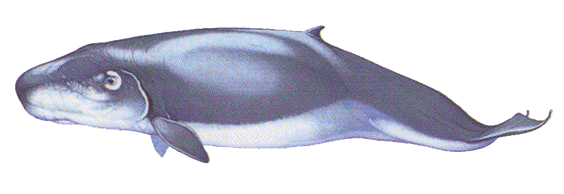The Pygmy Sperm Whale
(Kogia breviceps)
Length: 2.7 - 3.4m (8 - 11ft) wt. 318 - 408 kg
The Pygmy Sperm whale is often confused with the Dwarf Sperm whale with the two only distinguished apart at close range. It tends to live far from shore in deep waters and has inconspicuous habits. This whale tends not to approach boats and is most likely seen when resting. It will float motionless at the surface, with the upperside of its head and back above water and its tail hanging down limp in the water. When startled, the Pygmy Sperm whale may eject a redish-brown fluid before diving, leaving behind a dense cloud in the water. While this action is not fully understood it is believed that it may be a decoy like the ink of a squid.
The Pygmy Sperm whale is dark blue-grey on the back, outer margin of the flippers and upper side of tail flukes, shading to pale grey on the flanks and dull white on the belly. Sometimes the belly has a pinkish tinge. The body is rather sharklike with a conical head which becomes more rectangular or squarish with age. A pale grey or white crescent shaped mark resembling the gill slits of a fish can be seen on the side of the head behind the eyes.

From the Suborder Odontoceti (toothed whale) the Pygmy Sperm whale has no functional teeth in the upper jaw but has 10-16 pairs of narrow inward-curved pointed teeth in the lower jaw. It has a tiny, underslung lower jaw.
The Pygmy Sperm whale has one blowhole which gives a low and inconspicuous blow. The whale has a tiny, strongly sickle-shaped, falcate dorsal fin nearly two-thirds along its back and a tail with a concave trailing edge with a distinct notch between the tail flukes. Its flippers are broad but short and are located far forward on its body.
Superfamily: Physeteroidea
Family: Kogiidae
Other names: Lesser Cachalot, Lesser Sperm whale, Short-headed Sperm whale.
Food: Squid, octopus, fish (deep-water), Decapod crustaceans.
The Pygmy Sperm whale is cosmopolitan in deep waters of most, if not all, temperate subtropical and tropical seas but it has not yet been recorded in the South Atlantic Ocean. Although poorly known through the lack of records of live animals it is known mainly from strandings. Records of beached Pygmy Sperm whales indicate that they are more common along the east coast of North America from Nova Scotia to Texas. Other areas include Peru, England, Holland, France, tip of South Africa, East Africa, Arabia, India, Sri Lanka, Southeast Australia, Tasman Sea, New Zealand, and the west coast of North America fro Washington to Baja California.
The world population size is unknown but apparently it is not common. It is not know if the populations are isolated.
| Bibliography | Whales on the Net |